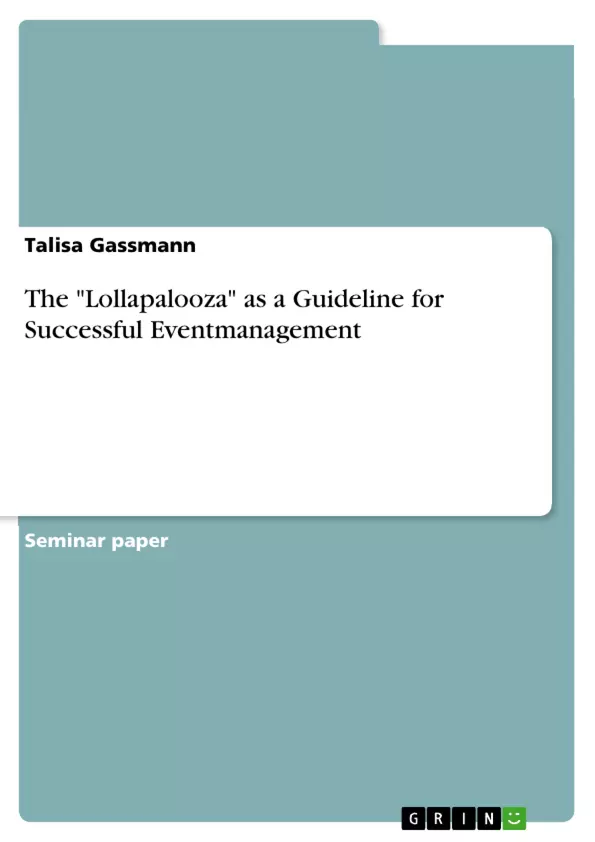The Lollapalooza is one of the most famous festivals around the globe. Important aspects of theoretical bases of event management are analyzed in this paper, like the general concept directly connected with Goldblatt's model. The question why events experience is primarily important is analyzed as well as the risk management. The last chapter thematizes the topic of legacy and impacts directly connected with environmental-, economic- and ecological impacts.
Inhaltsverzeichnis (Table of Contents)
- 1. Lollapalooza's event concept
- 2. Event experiences
Zielsetzung und Themenschwerpunkte (Objectives and Key Themes)
This text aims to analyze the Lollapalooza music festival, categorizing it within the context of mega-events and examining the crucial role of event experience design in its success. The analysis utilizes existing event management frameworks to understand the festival's planning and execution.
- Categorization of Lollapalooza as a mega-event
- Application of Goldblatt's five Ws model to event planning
- The importance of stakeholder engagement in festival success
- The significance of event experience design in shaping customer loyalty
- The creation of immersive experiences at Lollapalooza
Zusammenfassung der Kapitel (Chapter Summaries)
1. Lollapalooza's event concept: This chapter categorizes Lollapalooza as a mega-event within the public sector, highlighting its massive scale, global reach, and significant socio-cultural and economic impacts. It then applies Goldblatt's five Ws model (Why, Who, When, Where, What) to analyze the festival's conceptualization and planning. The "Why" focuses on the festival's role in celebrating cultural heritage and fostering community, while the "Who" identifies primary and secondary stakeholders crucial for its success. The "When" and "Where" detail the festival's annual July timeframe and its location in Chicago's Grant Park, with a discussion of its expansion to other locations. Finally, the "What" defines the festival's product as a unique blend of music, diverse participants, and behind-the-scenes contributions, culminating in a shared experience. The chapter emphasizes the interconnectedness of these factors in Lollapalooza's overall success.
2. Event experiences: This chapter delves into the critical role of event experiences in the success of events like Lollapalooza. It emphasizes that creating positive and memorable experiences is key to fostering customer loyalty and satisfaction. The chapter explores the concept of event experience design and its aim to create an overarching narrative throughout the event journey. It highlights the importance of understanding audience needs and desires to design experiences that resonate. While acknowledging the influence of uncontrollable factors on experience, the chapter stresses the importance of striving for immersion and creating unforgettable moments at the Lollapalooza festival.
Schlüsselwörter (Keywords)
Lollapalooza, mega-event, event experience design, Goldblatt's five Ws, stakeholder engagement, customer loyalty, immersion, cultural event, public sector event, festival planning.
Lollapalooza Event Analysis: Frequently Asked Questions
What is the purpose of this document?
This document provides a comprehensive preview of an analysis of the Lollapalooza music festival. It includes the table of contents, objectives, key themes, chapter summaries, and keywords. The analysis focuses on categorizing Lollapalooza as a mega-event and examining the role of event experience design in its success.
What are the key themes explored in the analysis?
The analysis explores several key themes, including the categorization of Lollapalooza as a mega-event, the application of Goldblatt's five Ws model to event planning, the importance of stakeholder engagement, the significance of event experience design in shaping customer loyalty, and the creation of immersive experiences at Lollapalooza.
How is Lollapalooza categorized in this analysis?
Lollapalooza is categorized as a mega-event within the public sector, highlighting its massive scale, global reach, and significant socio-cultural and economic impacts.
What is Goldblatt's five Ws model, and how is it applied?
Goldblatt's five Ws model (Why, Who, When, Where, What) is used to analyze Lollapalooza's planning. The "Why" focuses on its cultural and community role; the "Who" identifies stakeholders; the "When" and "Where" detail the timing and location; and the "What" defines the festival's unique product and shared experience.
What is the importance of stakeholder engagement in the success of Lollapalooza?
The analysis highlights the crucial role of stakeholder engagement in ensuring the success of the festival. Identifying and managing relationships with various stakeholders is presented as vital for effective planning and execution.
What is the role of event experience design in Lollapalooza's success?
The analysis emphasizes the critical role of event experience design in fostering customer loyalty and satisfaction. Creating positive and memorable experiences is presented as key to the festival’s overall success. The analysis explores the creation of an overarching narrative and the importance of understanding audience needs to design effective and resonant experiences.
What aspects of the Lollapalooza experience are considered for creating immersion?
The analysis stresses the importance of striving for immersion and creating unforgettable moments at Lollapalooza. While acknowledging uncontrollable factors, the text emphasizes the proactive design elements that contribute to an immersive experience for attendees.
What are the chapter summaries?
Chapter 1 categorizes Lollapalooza as a mega-event and applies Goldblatt's five Ws model to its planning. Chapter 2 delves into the critical role of event experiences in the festival's success, emphasizing the creation of positive and memorable experiences to foster customer loyalty.
What are the keywords associated with this analysis?
Keywords include Lollapalooza, mega-event, event experience design, Goldblatt's five Ws, stakeholder engagement, customer loyalty, immersion, cultural event, public sector event, and festival planning.
- Quote paper
- Talisa Gassmann (Author), 2021, The "Lollapalooza" as a Guideline for Successful Eventmanagement, Munich, GRIN Verlag, https://www.grin.com/document/1167308



